| Article ID | Journal | Published Year | Pages | File Type |
|---|---|---|---|---|
| 2562452 | Pharmacological Research | 2010 | 10 Pages |
Monoacylglycerol lipase (MGL) and fatty-acid amide hydrolase (FAAH) degrade the endocannabinoids 2-arachidonoylglycerol (2-AG) and anandamide (AEA), respectively. Pharmacological inhibition of these enzymes in the periphery may elucidate the role of endocannabinoids in controlling nociceptive transmission. We compared effects of the MGL inhibitor JZL184, the FAAH inhibitor URB597, and the endocannabinoid uptake inhibitor VDM11, administered locally in the paw, on behavioral hypersensitivities produced by capsaicin, the pungent ingredient in hot chili peppers. Intradermal capsaicin (10 μg i.pl.) produced nocifensive behavior, thermal hyperalgesia, and mechanical allodynia in rats. JZL184 (100 μg i.pl.) suppressed capsaicin-induced nocifensive behavior and thermal hyperalgesia without altering capsaicin-evoked mechanical allodynia. Effects of JZL184 were blocked by either the CB1 antagonist AM251 (80 μg i.pl.) or the CB2 antagonist AM630 (25 μg i.pl.). URB597 (75 μg i.pl.) suppressed capsaicin-induced mechanical allodynia without altering capsaicin-evoked thermal hyperalgesia or nocifensive behavior. Effects of URB597 were blocked by AM251 (80 μg i.pl.), but not by AM630 (25 μg i.pl.). VDM11 (100 μg i.pl.) suppressed capsaicin-evoked hypersensitivity for all three dependent measures (nocifensive behavior, thermal hyperalgesia, and mechanical allodynia), suggesting an additive effect following putative elevation of both AEA and 2-AG. The VDM11-induced suppression of capsaicin-evoked nocifensive behavior and thermal hyperalgesia was blocked by either AM251 (80 μg i.pl.) or AM630 (25 μg i.pl.), as observed with JZL184. The VDM11-induced suppression of capsaicin-evoked mechanical allodynia was blocked by AM251 (25 μg i.pl.) only, as observed with URB597. Thus, peripheral inhibition of enzymes hydrolyzing 2-AG and AEA suppresses capsaicin-evoked behavioral sensitization with distinct patterns of pharmacological specificity and in a non-overlapping and modality-specific manner. Modulation of endocannabinoids in the periphery suppressed capsaicin-evoked nocifensive behavior and thermal hyperalgesia through either CB1 or CB2 receptor mechanisms but suppressed capsaicin-evoked mechanical allodynia through CB1 mechanisms only. Inhibition of endocannabinoid transport was more effective in suppressing capsaicin-induced sensitization compared to inhibition of either FAAH or MGL alone. These studies are the first to unveil the effects of pharmacologically increasing peripheral endocannabinoid levels on capsaicin-induced behavioral hypersensitivities. Our data suggest that 2-AG, the putative product of MGL inhibition, and AEA, the putative product of FAAH inhibition, differentially suppress capsaicin-induced nociception through peripheral cannabinoid mechanisms.
Graphical abstractInhibitors of fatty-acid amide hydrolase (URB597), monoacylglycerol lipase (JZL184), and endocannabinoid transport (VDM11) differentially suppress capsaicin-evoked behavioral hypersensitivities through peripheral cannabinoid mechanisms.Figure optionsDownload full-size imageDownload as PowerPoint slide
